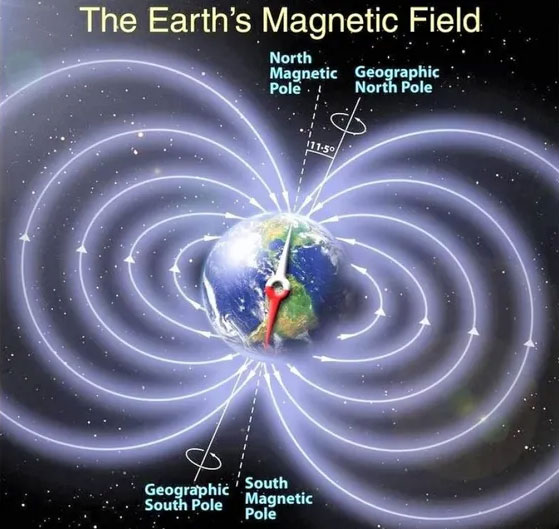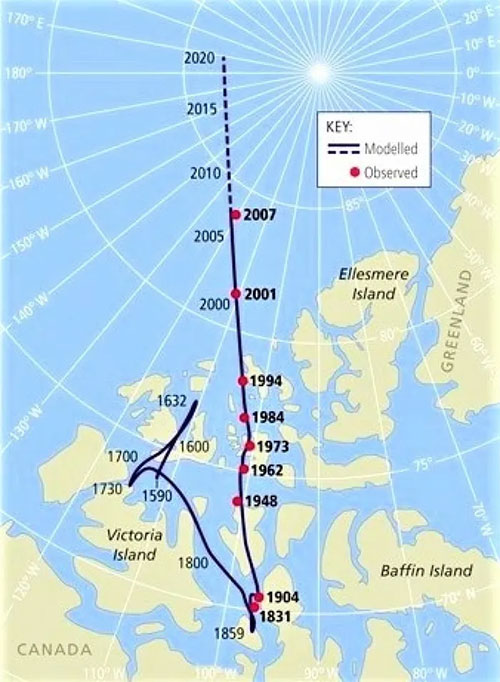The Earth’s Magnetic North Pole continues to shift for reasons that science has yet to fully explain. However, this movement is not truly dangerous and is within human control.
The Earth’s Magnetic North Pole
In fact, there are eight types of North Poles, but three are of primary interest: Geographic North Pole (the northernmost point on the Earth’s imaginary axis of rotation), Magnetic North Pole (the northern end of a compass needle that points north; it does not coincide with the Geographic North Pole, but is close enough for navigation), and Geomagnetic North Pole (the point where magnetic field lines enter the Earth perpendicular to its surface, which is not fixed).
The Earth’s Magnetic North Pole, where magnetic field lines enter the Earth perpendicular to the surface, is a non-fixed position. The English philosopher William Gilbert first calculated the existence of the Magnetic North Pole in 1590. By 1831, British Naval Officer James Clark Ross became the first person to reach it. By 1898, the Magnetic North Pole had meandered through various islands and waterways in northern Canada.

The Magnetic North Pole and Geographic North Pole are 11.5 degrees apart. (Source: popularmechanics.com).
Since 1898, it has been moving in a north-northwest direction. The speed of movement at the beginning of the 20th century was about 5 miles per year; by the late 1940s, the Magnetic North Pole had moved approximately 400 km northwest, and since 1970, it has started to move faster. Currently, the Magnetic North Pole is moving at about 25 miles per year; since the 1990s, it has moved about 970 km and is now located in the central Arctic Ocean.
As of February 2019, it was at coordinates 86.54°N, 170.88°E in the Arctic waters. The Magnetic North Pole is expected to shift towards the Eastern Hemisphere, heading towards Siberia, Russia. Soon, it will reach coordinates 86.471°N and 178.755°W, less than 212 nautical miles from the Geographic North Pole. Interestingly, the South Pole of the Earth does not shift and has a relatively stable position. The Magnetic South Pole does not coincide with the Geographic South Pole; in February 2019, it was located at 64.13°S, 136.02°E off the coast of Antarctica.
Tracking Movement in the Earth’s Core
Scientists have not yet explained why the planet’s magnetic field, which protects Earth from deadly solar winds, continues to shift and change, despite existing theories based on the Barnett-Einstein effect having been quite effective for decades. Some suggest that the reason the Magnetic North Pole moves about 25 miles each year is due to earthquakes, electrical fluctuations in the Van Allen radiation belt, the ionosphere, and magnetosphere, but largely due to the physical structure within our planet.
The magnetic field of Earth is generated deep within the Earth’s core, approximately 3,200 km below the surface. It consists of a mass of molten metal that continuously rotates in the Earth’s core. Changes in the flow of that metal will alter the magnetic field lines of the Earth and the magnetic poles where they converge. It is hypothesized that the geomagnetic impulse in 2016 in South America led to a change in the Earth’s magnetic field structure, which is a contributing factor. The Earth’s magnetic field exists thanks to liquid nickel and iron in the outer core of the planet, about 1,800 miles from the surface.
Scientists believe that the increased speed of movement of the Magnetic North Pole could signal the early stages of a geomagnetic reversal, where the North and South magnetic poles will flip and exchange places. They report that at least 184 geomagnetic reversals have occurred over the past 83 million years, approximately every 100,000 to 1 million years, and these reversals typically take between 1,000 to 10,000 years to complete. The last complete and long-lasting reversal occurred 786,000 years ago, and it could happen within a human lifetime.
A brief reversal occurred 41,000 years ago during the Ice Age, but it only lasted “440 years” before reverting. Factors hypothesized to trigger these periodic geomagnetic reversals include extraterrestrial extinction-level impact events, continental-sized rock slabs sinking into the area between the mantle and the outer liquid core, and large tectonic plate movements, which weaken the Earth’s magnetic field, making rearrangement of the fields more likely, even leading to geomagnetic reversal.

Since the 1900s, the Magnetic North Pole has shifted northward. (Source: oceannavigator.com).
The movement of the Magnetic North Pole affects the World Magnetic Model (WMM), which tracks the field and informs compasses, GPS on smartphones, and navigation systems on aircraft and ships, leading to inaccuracies. Traditionally, the WMM is updated every five years, as the pole movement during this period is relatively predictable. The last adjustments were made in 2015.
The Importance of the Magnetic Pole for Navigation Models
Like the European and American militaries, commercial airlines and GPS applications on smartphones also use the WMM-based navigation system to help users determine their location and navigate accordingly. This is why the British Geological Survey and the National Oceanic and Atmospheric Administration (NOAA) update the WMM every five years.
However, on February 4, 2019, they had to update the model ahead of schedule due to the rapid movements of the Magnetic North Pole. The update was necessary for GPS systems on smartphones, navigation for aircraft, ships, and military devices to operate accurately.
The authors of a new study have developed ideas about why the Magnetic North Pole may be moving—and are seeking ways to predict this change. New maps also indicate that the Magnetic North Pole is shifting eastward from the prime meridian (which runs through the Royal Observatory in Greenwich, England) starting from September 2029. But even with these periodic updates, geomagnetic phenomena also make it challenging to keep the model accurate. This requires certain adjustments for all navigation systems—from GPS to Google Maps on smartphones.
Some speculate that the geomagnetic reversal event has been overdue; recent changes in the Magnetic North Pole could be a sign of an impending disaster related to the magnetic field. If we lose the magnetic field, we will lose our atmosphere. However, this is extremely unlikely to happen, as the Earth’s core will continue to rotate.
The GPS system has replaced most traditional navigation devices, but many still rely on compasses for orientation in situations underwater or underground where satellite communication is impossible. Currently, no one knows whether the Earth’s two magnetic poles will swap places or if the magnetic field will stabilize as it once was. Both scenarios have occurred in history and have not significantly affected living organisms. Nevertheless, modern navigation systems depend on the Magnetic North Pole and will need recalibration if the poles continue to shift.


















































